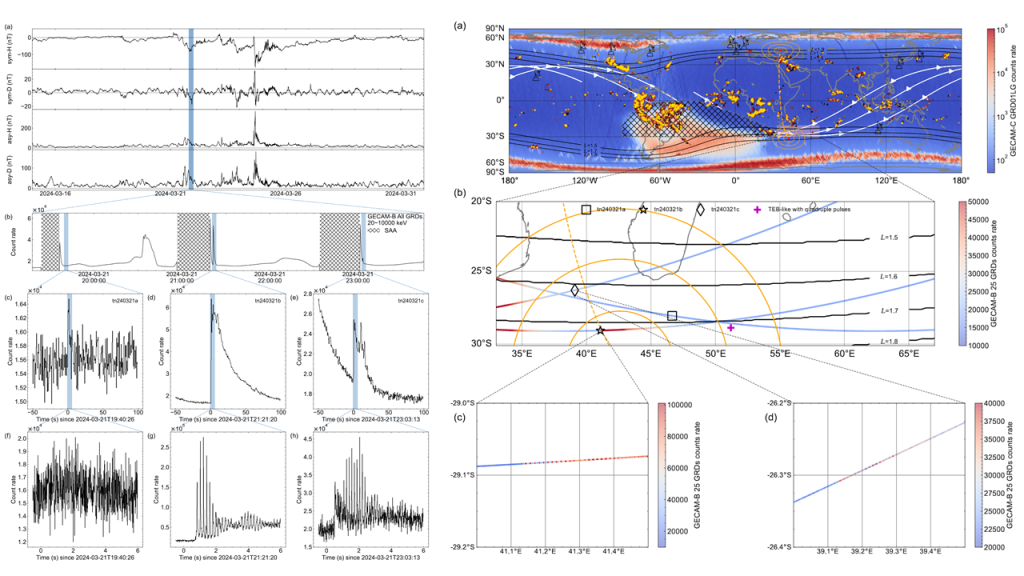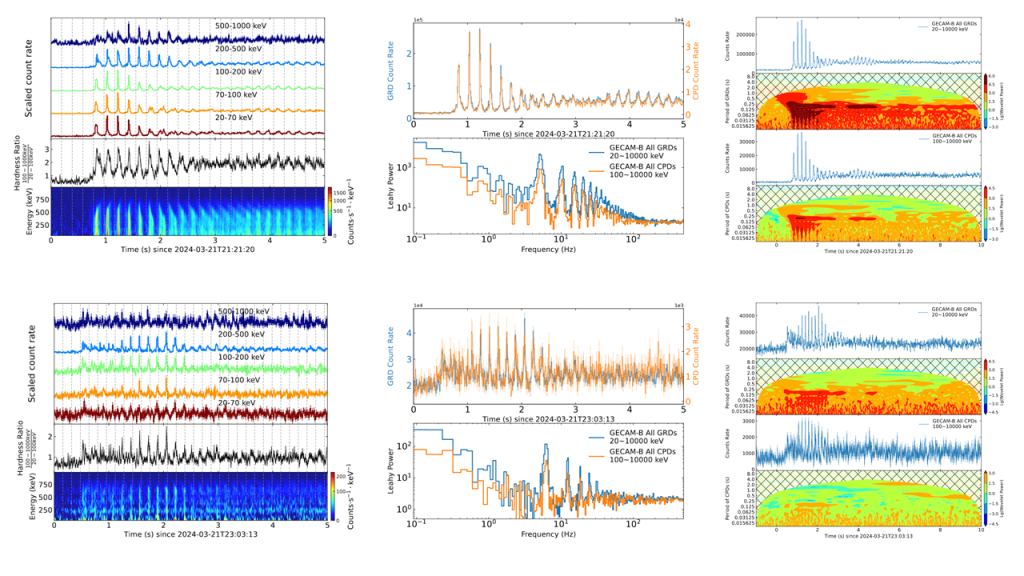
Chen-Wei Wang
王晨巍
cwwang@ihep.ac.cn
IHEP, CAS, China
By the way, I would like to express my heartfelt gratitude to all my collaborators. They are all talented and kind. So if you have any question about these works, or if you have good ideas and are willing to collaborate, please do not hesitate to contact me or them.
This section includes my major publications of Astrophysics
Type I gamma-ray bursts (GRBs) are believed to originate from compact binary mergers usually with a duration of main emission less than 2 s. However, recent observations of GRB 211211A and GRB 230307A indicate that some merger-origin GRBs could last much longer. Since they show strikingly similar properties (indicating a common mechanism), which are different from the classic “long”-short burst (e.g., GRB 060614), we find they form an interesting subclass of type I GRBs, and we suggest to name them as type IL GRB. We find that the prompt emission of type IL GRB is composed of three episodes:
(1) a precursor followed by a short quiescent (or weak emission) period,
(2) a long-duration main emission,
(3) an extended emission.
With this burst pattern, a series good candidates was found in the Fermi/Gamma-ray Burst Monitor archive data. Thus, this burst pattern could be a good reference for rapidly identifying type IL GRBs and very helpful for conducting low-latency follow-up observation.
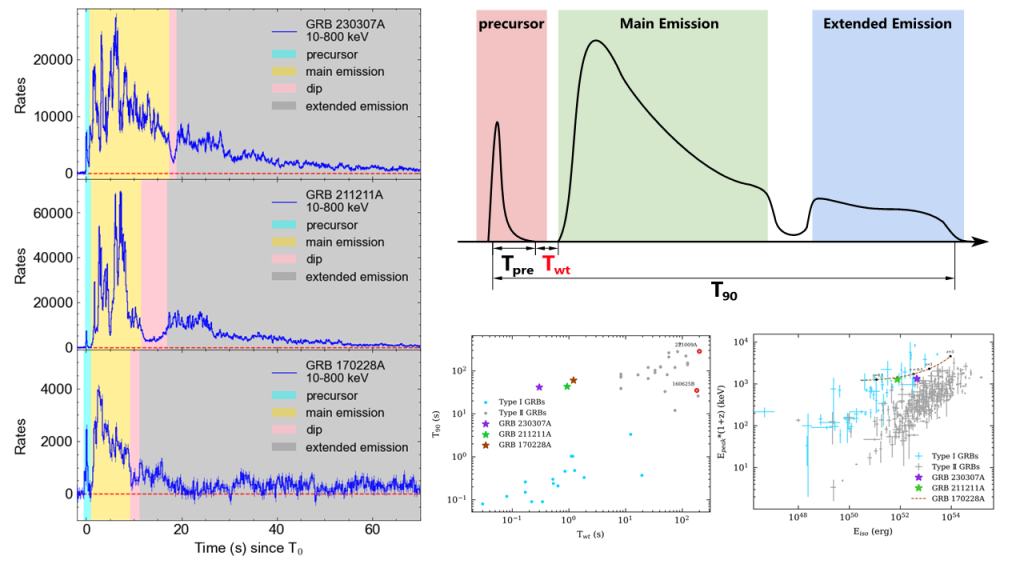
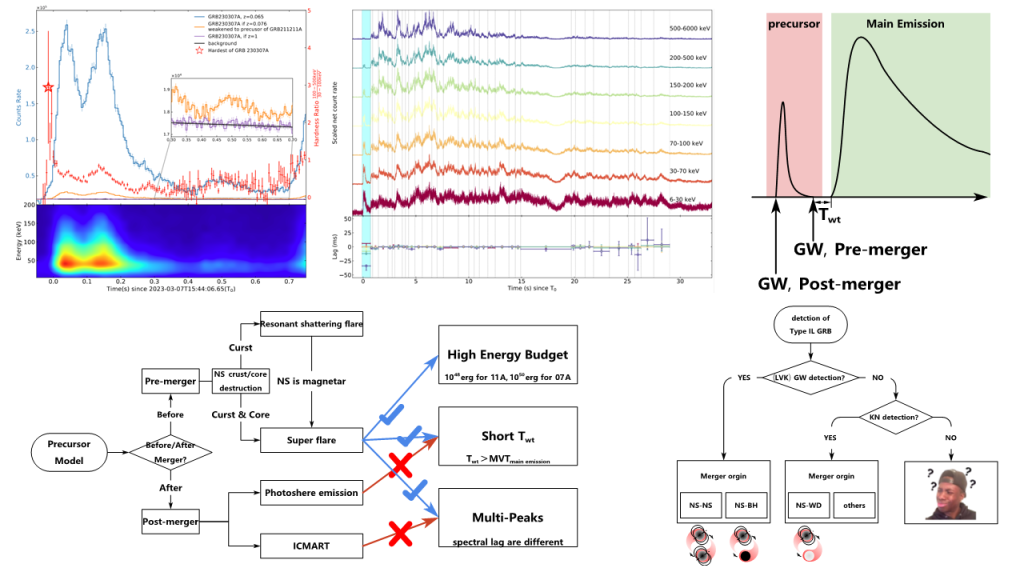
With comprehensive spectral and temporal analysis of the bright intermediate duration GRB 240825A, which is rare to find to have a “positive-to-negative transition” in the spectral lag, we noticed that this should be interpreted as misalignment in the cross-correlation function analysis of pulses, caused by evolution of the soft and hard components. This suggests that the “positive-to-negative transition” of spectral lag detected in some GRBs with insufficient observational data may be a non-physical illusion.
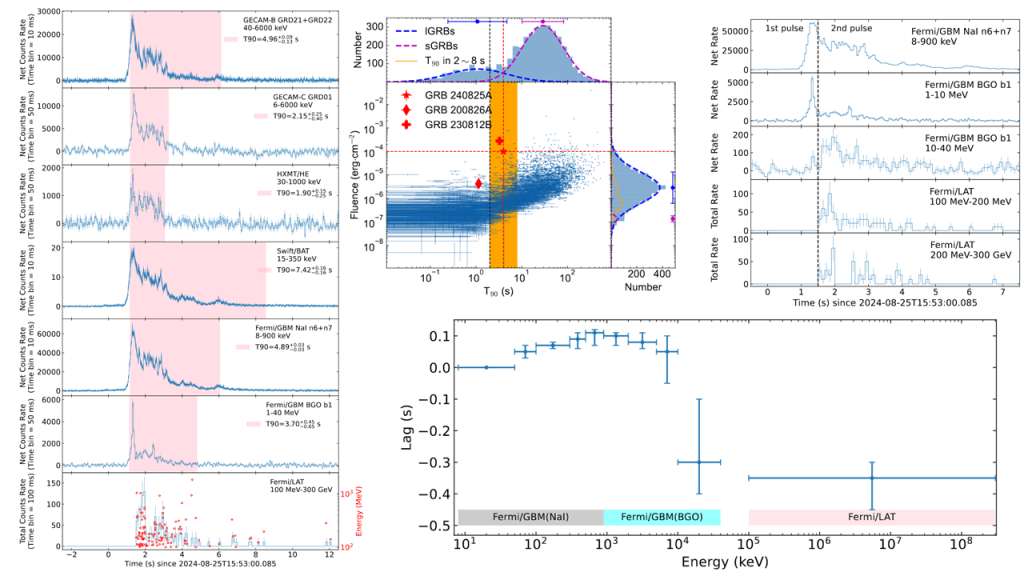
Based on the joint observations of GRB 240825A from multiple gamma-ray telescopes, we conduct a comprehensive temporal and spectral analysis to identify the presence and evolution of all three components. The bulk Lorentz factor of this bright and relatively short-duration burst is independently obtained from the thermal and hard nonthermal components, supporting a jet penetration scenario.
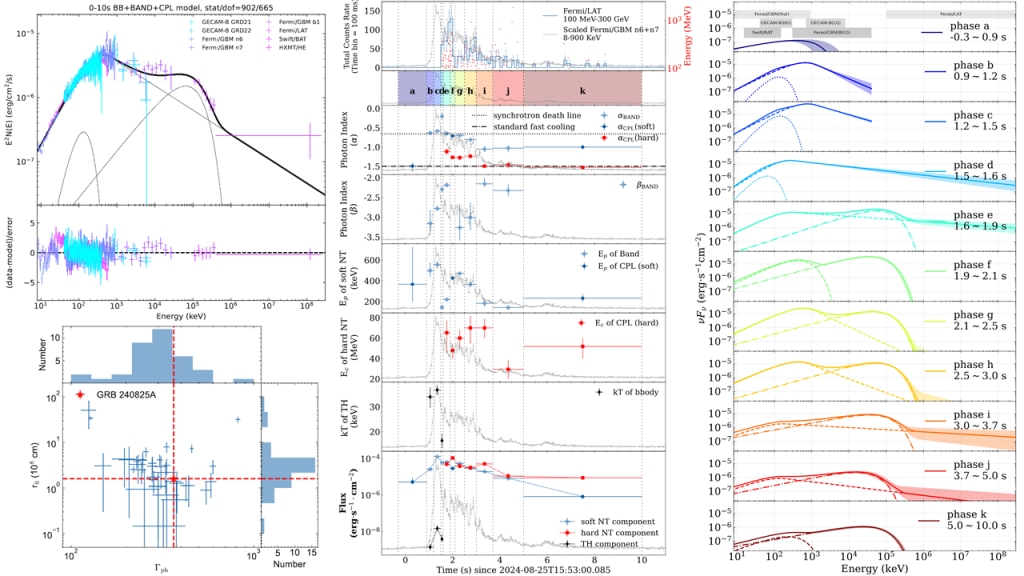
The central engine that powers gamma-ray bursts (GRBs), the most powerful explosions in the universe, is still not identified. Besides hyper-accreting black holes, rapidly spinning and highly magnetized neutron stars, known as millisecond magnetars, have been suggested to power both long and short GRBs. The presence of a magnetar engine following compact star mergers is of particular interest as it would provide essential constraints on the poorly understood equation of state for neutron stars. Indirect indications of a magnetar engine in these merger sources have been observed in the form of plateau features present in the X-ray afterglow light curves of some short GRBs. Additionally, some X-ray transients lacking gamma-ray bursts (GRB-less) have been identified as potential magnetar candidates originating from compact star mergers. Nevertheless, smoking gun evidence is still lacking for a magnetar engine in short GRBs, and the associated theoretical challenges have been raised.
Here we present a comprehensive analysis of the broad-band prompt emission data of a peculiar, very bright GRB 230307A. Despite its apparently long duration, the prompt emission and host galaxy properties are consistent with a compact star merger origin, as suggested by its association with a kilonova. Intriguingly, an extended X-ray emission component shows up as the γ-ray emission dies out, signifying the likely emergence of a magnetar central engine. We also identify an achromatic temporal break in the high-energy band during the prompt emission phase, which was never observed in previous bursts and reveals a narrow jet with half opening angle of approximately ~3.4deg (R_GRB / 10^15 cm)^(-1/2), where R_GRB is the GRB prompt emission radius.
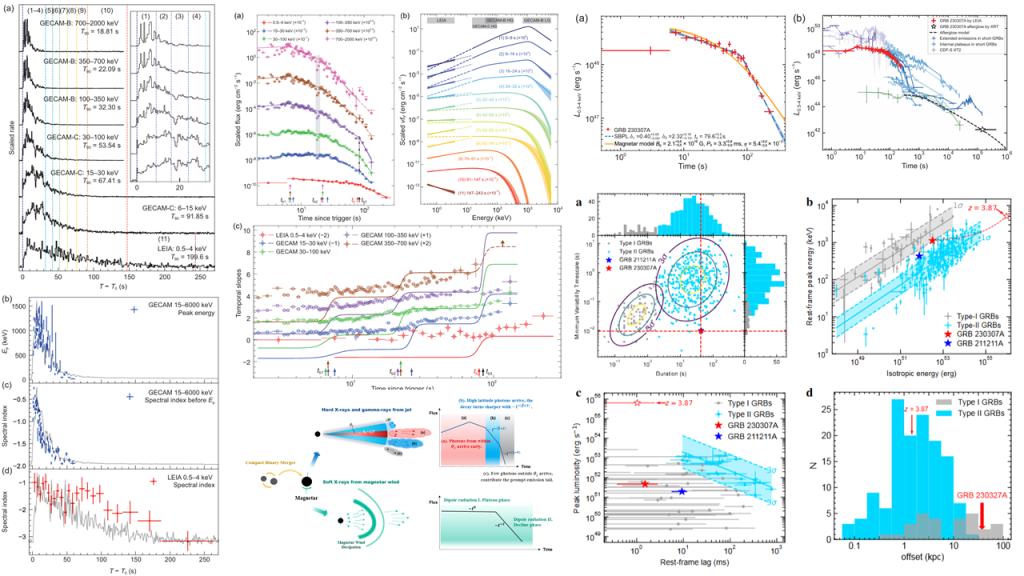
1. Apart from a precursor and a significant dip, there looks like an overall FRED shape, especially in low resolution lightcurve, which corresponding to the slow component.
2. Many spikes are revealed in high resolution light curves, which is considered as the fast component.
These features inspired us to investigate does the collection of these spikes act as a FRED pulse. Here we demonstrate that the rapidly variable components of its prompt emission compose an overall broad single pulse-like profile. Although these individual rapid components are aligned in time across all energy bands, this overall profile conspires to show a well-defined energy-dependent behavior that is typically seen in single GRB pulses. Such a feature demonstrates that the prompt emission of this burst is from many individual emitting units that are casually linked in a emission site at a large distance from the central engine. Such a scenario is in natural consistency with the internal-collision-induced magnetic reconnection and turbulence framework, which invokes many minijets due to local magnetic reconnection that constantly appear and disappear in a global magnetically dominated jet.
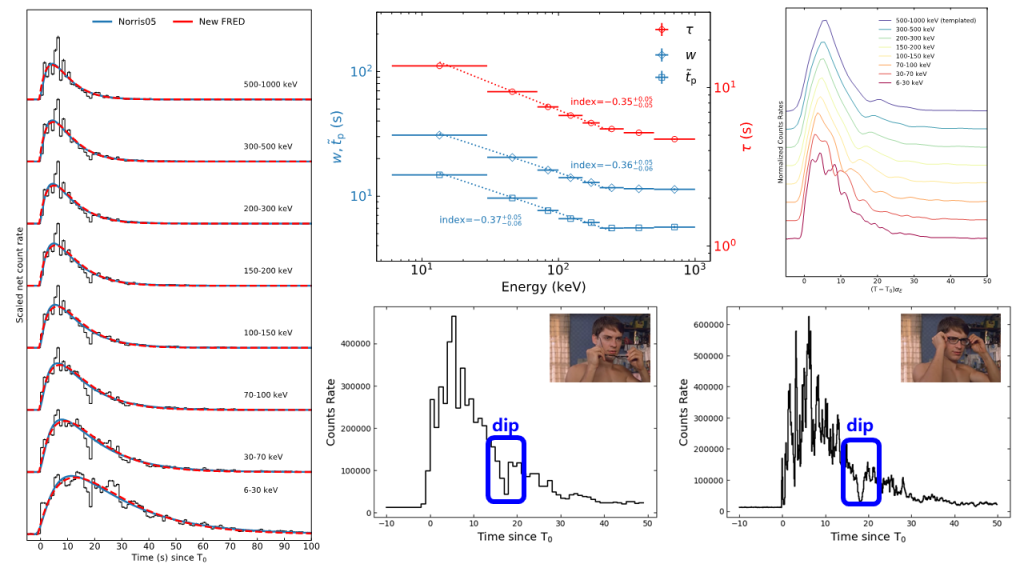
An analogue:
Suppose we see a big shadow of a huge fish swimming in the sea, and around the big fish there are shapes of smaller fishes.
It is hard to say this is a big mother fish with many baby fishes or is just a school of baby fishes?
But then, we suddenly noticed that, at the place where the mother fish should be, there is a void, transparent hole.
So that immediately tell us, that, there is only a school of baby fishes with no big mother fish.
But the school of baby fish are coordinating themselves so that they are acting like a big fish.
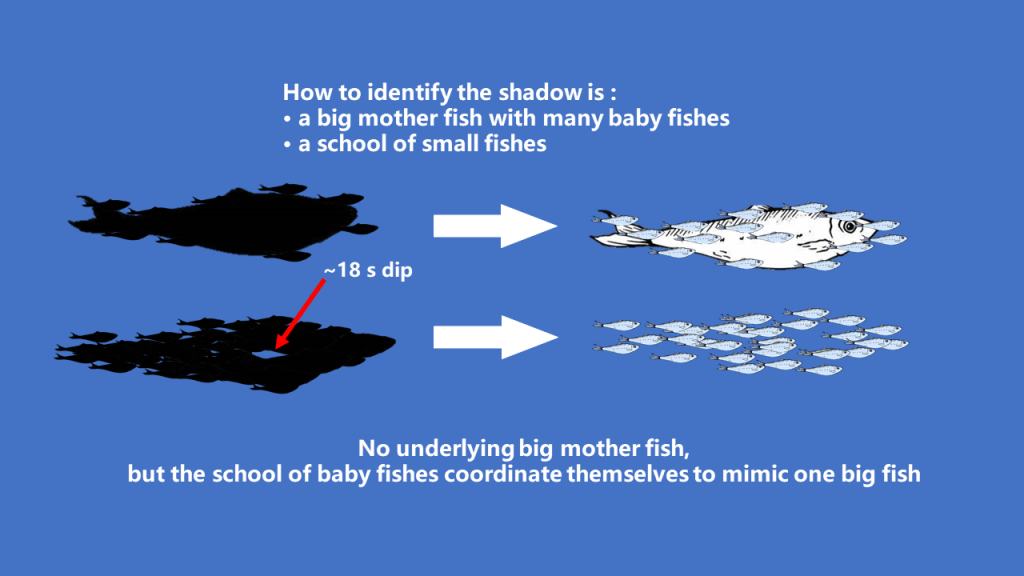
If all the fast pulses are from separated shocks at a small emission radius, which can be estimated by the variability of fast pulse. The energy-dependent lag and width generally apply to each fast pulse. Even if there is a stretching factor in low energies to make pulses broader, the stretching factor scales with the duration of short pulses. There is no way to reproduce a large stretching factor in the scale of the broad pulse by superposing these short pulses.
While in the ICMART scenario, one fast pulse corresponds to a mini-jet. But all the mini-jet are from a single expanding fluid. The magnetic field strength decays with the fluid expands. So we can naturally have the overall pulse shape, overall shape-energy dependence, and no underlying slow pulse required.
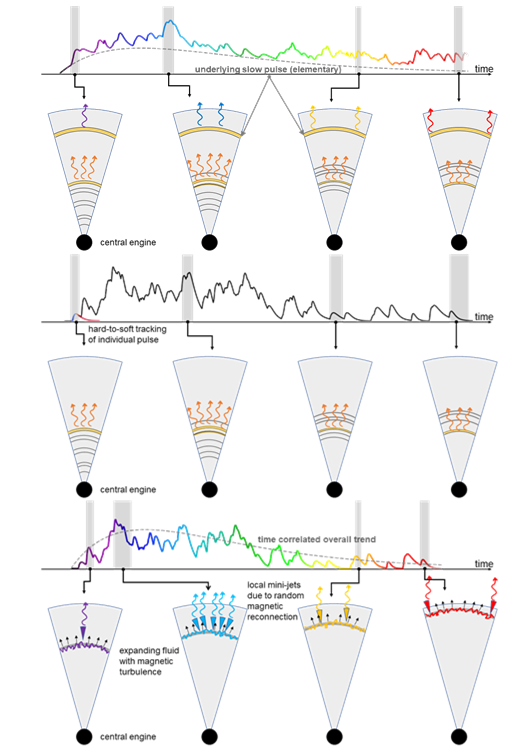
In this study, we present the pulse profile of the unique and the second-brightest gamma-ray burst GRB 230307A, and analyze its temporal behavior using a joint GECAM–Fermi Gamma-ray Burst Monitor (GBM) time-resolved spectral analysis. The utilization of GECAM data is advantageous as it successfully captured significant data during the pileup period of the Fermi/GBM. We investigate the evolution of its flux, photon fluence, photon flux, peak energy, and the corresponding hardness–intensity and hardness–flux correlations. The findings within the first 27 s exhibit consistent patterns reported previously, providing valuable insights for comparing observations with predictions from the synchrotron radiation model invoking an expanding shell. Beyond the initial 27 s, we observe a notable transition in the emitted radiation, attributed to high-latitude emission, influenced by the geometric properties of the shells and the relativistic Doppler effects. By modeling the data within the framework of the large-radius internal shock model, we discuss the required parameters as well as the limitations of the model. We conclude that a more complicated synchrotron emission model is needed to fully describe the observational data of GRB 230307A.
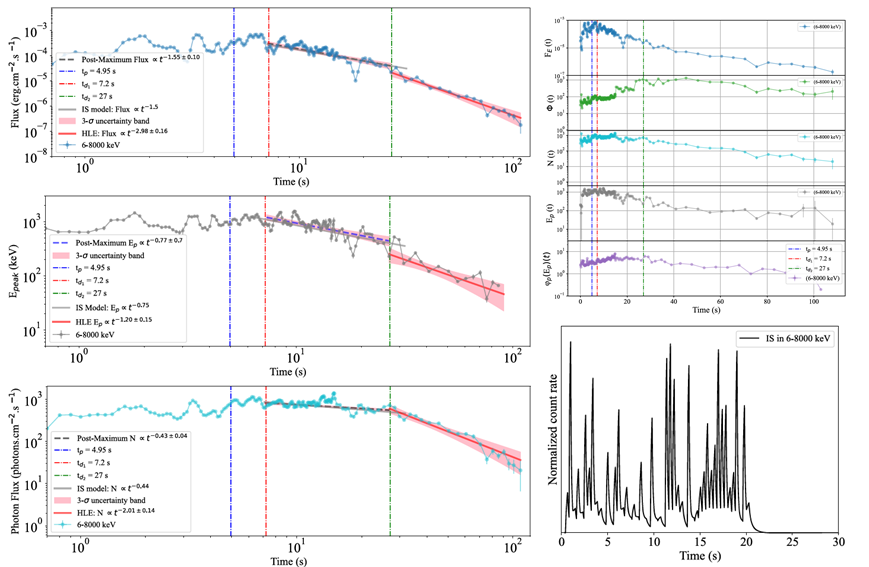
This section includes my major publications of insturments
Now, the simulation results have been well validated by observations. These results provide important reference for the development of payload, design of observation strategies, in-flight calibration of instrument and research of scientific objectives.
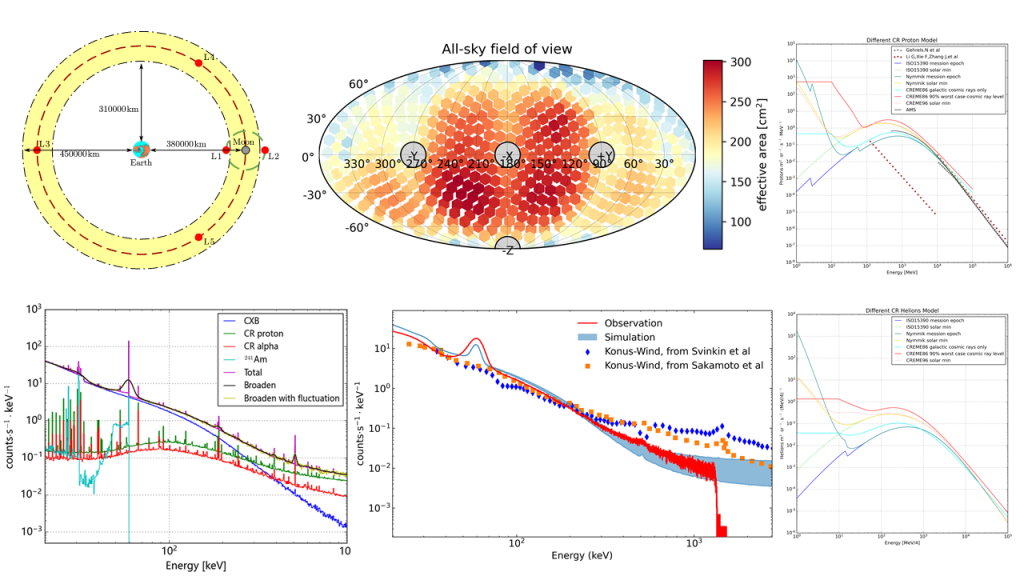
This section includes my major publications of Methods
The extremely short duration nature of the events like Terrestrial Electron Beams (TEBs) makes wide FOV X-ray and gamma-ray observatories (including GECAM, CGRO/BATSE, Fermi/GBM, and so on) the main force instruments for detecting these short timescale charged particle events. However, these astronomical telescopes did not provide constraints on pitch angles in the past, resulting in long-term lack of observation information on the pitch angles of short-duration particle events.
As an X-ray and gamma-ray all-sky monitor aiming for high energy astrophysical transients, GECAM has also made a series of observational discoveries on burst events of gamma-rays and particles in the low Earth orbit. Here we propose a novel method for GECAM and similar instruments to measure the pitch angle of charged particles based on detector counts distribution. The basic conception of this method and simulation studies are described. With this method, the pitch angle of a peculiar electron precipitation event detected by GECAM-C is derived to be about 90 degree, demonstrating the feasibility of our method. We note that the application of this method on GECAM-style instruments may open a new window for studying space particle events, such as Terrestrial Electron Beams (TEBs) and Lightning-induced Electron Precipitations (LEPs).
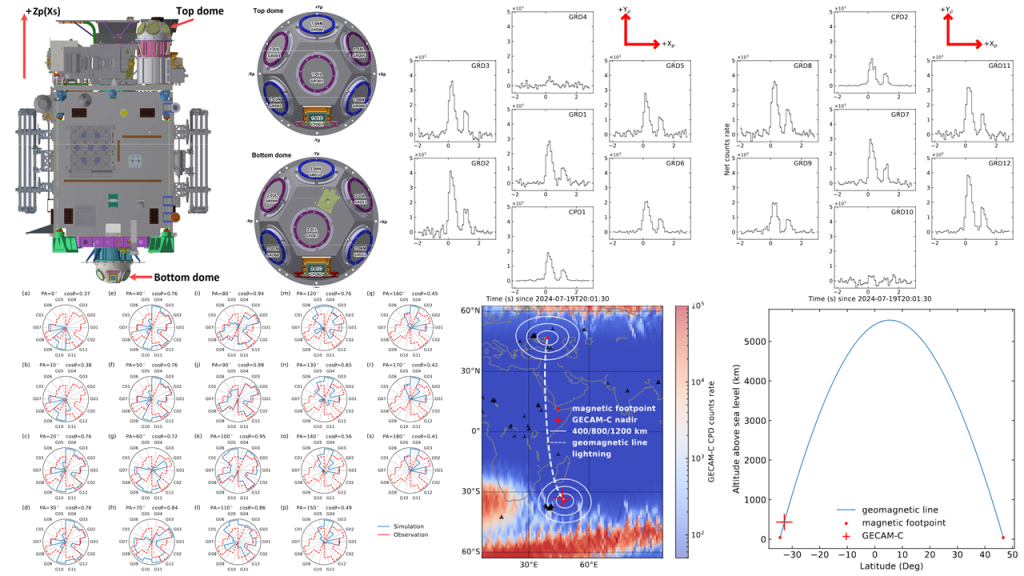
This section includes my major publications of Space physics
Charged particle precipitation typically manifests as a gradual increase and decrease of flux observed by space detectors. Cases with rapidly flux variation are very rare. Periodic events are even more extraordinary. These oscillating particle precipitation (OPP) events are usually attributed to the bounce motion of electrons, which are induced by lightning. Owing to the observation limitations, there has been debate regarding whether these oscillations originate from temporal flux evolution or spatial structure evolution. Here we report three peculiar charged particle precipitation events detected by GECAM during a geomagnetic storm on March 21, 2024, with two exhibiting significant periodicity. These events were observed around the same region during three consecutive orbits. Through comprehensive temporal and spectral analyses, we revealed that one of the OPP events exhibited a transition in spectral lag of mini-pulses, shifting from “softer-earlier” to “softer-later” while showing no significant time evolution in overall frequency characteristics. And there is no association found between these two OPP events and lightning activity. Several possible scenarios are discussed to explain these charged particles with a life time of more than 3.5 hours, but the nature of these three events remains an enigma. We suggest that these GECAM-detected OPP events may represent a new type of particle precipitation event or a peculiar Lightning-induced Electron Precipitations (LEPs).
